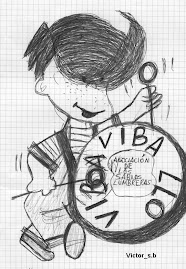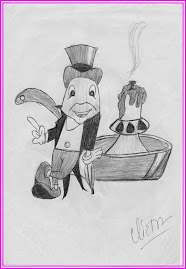
http://www.links2love.com/christmas_songs_10.htm
http://es.youtube.com/watch?v=Py0dsLH9Zck&eurl=http://www.links2love.com/christmas_songs_10.htm
Introduction
Conventionally, Santa Claus is portrayed as a kindly, round-bellied, merry, bespectacled man in a red suit trimmed with white fur, with a long white beard. On Christmas Eve, he rides in his flying sleigh (pulled by reindeer) from house to house to give presents to children. During the rest of the year he lives at the North Pole, in Finnish Lapland at Korvatunturi, or Dalecarlia in Sweden (traditions vary) together with his wife, Mrs. Claus, and his elves who serve as his toy production staff.
Amongst virtually all adults the nonexistence of Santa Claus is a given, but many young children believe strongly in his existence. A majority of parents, at least in English-speaking households that celebrate Christmas, either actively attempt to convince their children of Santa's existence, or at least keep the source of their children's presents a secret from them and so fail to disprove the myth. Children who believe in the existence of Santa often tend to lose such beliefs by early primary school, as their ability to distinguish fantasy from reality improves and older children disillusion them.
There is an occasional controversy in parenting as to whether it is appropriate to perpetuate the myth of Santa Claus to children. Some parents are concerned that it is wrong to lie to children and that it can be traumatic to learn that there is no Santa Claus. Other parents believe that it is no more harmful than any other folk tale, and that it can help children gain confidence in their maturity in themselves to discover the "secret" of his non-existence. Furthermore, many children, upon being disillusioned, often maintain the pretense for younger siblings so they can enjoy the belief themselves for a bit longer.
Origins
Conventionally, Santa Claus is portrayed as a kindly, round-bellied, merry, bespectacled man in a red suit trimmed with white fur, with a long white beard. On Christmas Eve, he rides in his flying sleigh (pulled by reindeer) from house to house to give presents to children. During the rest of the year he lives at the North Pole, in Finnish Lapland at Korvatunturi, or Dalecarlia in Sweden (traditions vary) together with his wife, Mrs. Claus, and his elves who serve as his toy production staff.
Amongst virtually all adults the nonexistence of Santa Claus is a given, but many young children believe strongly in his existence. A majority of parents, at least in English-speaking households that celebrate Christmas, either actively attempt to convince their children of Santa's existence, or at least keep the source of their children's presents a secret from them and so fail to disprove the myth. Children who believe in the existence of Santa often tend to lose such beliefs by early primary school, as their ability to distinguish fantasy from reality improves and older children disillusion them.
There is an occasional controversy in parenting as to whether it is appropriate to perpetuate the myth of Santa Claus to children. Some parents are concerned that it is wrong to lie to children and that it can be traumatic to learn that there is no Santa Claus. Other parents believe that it is no more harmful than any other folk tale, and that it can help children gain confidence in their maturity in themselves to discover the "secret" of his non-existence. Furthermore, many children, upon being disillusioned, often maintain the pretense for younger siblings so they can enjoy the belief themselves for a bit longer.
Origins
The modern Santa Claus is a composite character made up from the merging of two quite separate figures. The first of these is Saint Nicholas of Myra, a bishop of Byzantine Anatolia (now in modern-day Turkey) famous for his generous gifts to the poor. In Europe he is still portrayed as a bearded bishop in canonical robes. The second character is Father Christmas, which remains the British name for Santa Claus. Father Christmas dates back at least as far as the 17th century in Britain, and pictures of him survive from that era, portraying him as a well-nourished bearded man dressed in a long, green, fur-lined robe. He typified the spirit of good cheer at Christmas, and was reflected in the 'Spirit of Christmas Present' in Charles Dickens' famous story, A Christmas Carol.
When the Dutch still owned the land that later became New York, they brought the Saint Nicholas' eve legend with them to the Americas, but without the red mantle and other symbols. The name Santa Claus is derived from the character's Dutch name, Sinterklaas. Note that in Dutch, the feast is called 'sinterklaas feest' and it celebrates the birthday ((Conflict: The Saint_Nicholas page states that it's his death day, not his birth day.)) of sinterklaas during sinterklaasavond ("sinterklaas's evening") on December 5th or in Belgium on December 6th.
In Washington Irving's History of New York, Sinterklaas was Americanized to "Santa Claus" but lost his bishop's apparel, and was at first pictured as a thick bellied Dutch sailor with a pipe in a green winter coat. Irving's book was a lampoon of the Dutch culture of new York, and much of this portrait is his joking invention. Santa Claus appeared in various colored costumes as he gradually became amalgamated with the figure of Father Christmas, but red soon became popular after he appeared wearing such on an 1885 Christmas card. His horse was converted to reindeer and a sleigh, the black peters (which were in fact Moorish slaves) were converted to elves, and, in an attempt to move the origin of the festivities away from their pagan background to a more Christian one, the date was moved forward a few weeks to the celebrated day of the birth of Jesus: Christmas.
In the United States, the tradition is to leave Santa a glass of milk and cookies; in Britain, he is given whisky and mince pies instead. British children also leave out a carrot for Rudolph, Santa's reindeer, and are told that if they are not good all year round, that they will receive coal in their stockings. Children following the Dutch custom for sinterklaas will "put out their shoe" — that is, leave hay and a carrot for his horse in a shoe before going to bed — sometimes weeks before the sinterklaas avond. The next morning they will find the hay and carrot replaced by a gift; often, this is a marchpane figurine. Naughty children were once told that they would be left a roe (a bundle of sticks) instead of sweets, but this practice has been discontinued.
Many postal services allow children to send letters to Santa Claus pleading their good behaviour and requesting gifts; these letters may be answered by postal workers or other volunteers. (Canada Post has a special postal code for letters to Santa Claus: H0H 0H0.)
Rudolph the Red-Nosed Reindeer has been immortalized in a Gene Autrey song, written by a Montgomery-Ward copywriter, which is frequently played at Christmas. As such, he is typically included as the sleigh's lead reindeer. The names of all the other reindeer were invented in the poem A Visit From St. Nicholas (better known today as The Night Before Christmas) ascribed to Clement Clarke Moore, although there is some question as to his authorship. It is suspected that the names Donner and Blitzen come from the German phrase Donner und Blitz which means Thunder and Lightning. An alternative explanation is that Donder is the original name of the seventh reindeer, as Donder en bliksem is Dutch for Thunder and Lightning. The reindeer are traditionally pictured with antlers, although male reindeer shed their antlers in the winter. (Female reindeer keep their antlers until spring.)
Many Christian churches dislike the secular focus on Santa and the materialist focus that present-giving gives to the holiday. They would prefer that focus be given to the birth of Jesus, their nominal reason for the Christmas celebration. It should be noted that the festivities at this time of year are predated by the Roman Saturnalia and Yule festivals which were subsumed within Christianity. It should also be noted that the date of Jesus' birth is not known. The connection between Saturnalia and Jesus' birth was a clerical decision in order to introduce a religious element into the more carnal festivities that the Christian laity were indulging in during winter solstice. As an example of the still surviving pagan imagery, in Nordic countries there is the Yule goat (Swedish julbock), a somewhat startling figure with horns which however will deliver the presents in Christmas eve, and a straw goat is a common Christmas decoration.
Historically, one of the first artists to capture Santa Claus' image as we know him today was Thomas Nast, an American cartoonist of the 19th century. In 1862, a picture of Santa illustrated by Nast appeared in Harper's Weekly. It is believed the inspiration for his image came from a mythical German character called Pelznickel (Furry Nicholas) who visited naughty children in their sleep. The book A History of Santa Claus was written by L. Frank Baum, the same man who wrote the Wizard of Oz. In Scandinavia, the Tomte is closely associated with Christmas, kindness and generosity. This blend of Nicholas of Myra and North European folklore helped popularize the design of Santa. (Urban legend has it that Santa Claus in his current guise was in fact created by Coca-Cola, though this is highly unlikely.) To this day, Santa Claus still appears on Coca-Cola products each year around Christmastime.
The depiction of Santa at the North Pole also reflected popular opinion about industry. In some images of the early 1900s, Santa was depicted as personally making his toys by hand in a small workshop like a craftsman. Eventually, the idea emerged that he had numerous elves responsible for making the toys, but the toys were still handmade by each individual elf working in the traditional manner. By the end of the century, the reality of mass mechanized production became more fully accepted by the Western public. That shift was reflected in the modern depiction of Santa's residence—now often humorously portrayed as a fully mechanized production facility, equipped with the latest manufacturing technology, and overseen by the elves with Santa and Mrs. Claus as managers. Many TV commercials depict this as a sort of humorous business, with Santa's elves acting as a sometimes michieviously disgruntled workforce, cracking jokes and pulling pranks on their boss.
"Santa" in shopping centres
Santa Claus is also a costumed character who appears at Christmas time in department stores or shopping malls. He is played by an actor, usually helped by other actor(s) (most often mall employees) dressed as elves or other creatures of folklore. His function is either to promote the store's image by distributing small gifts to children, or to provide a seasonal experience to children by having them sit on his knee, state what they wish to get, and often have a photograph taken. The area set up for this purpose is festively decorated, usually with a large throne, and is called variously "Santa's Grotto", "Santa's Workshop" or a similar term. In America the most notable of these is the Santa at the flagship Macy's store in New York City - he arrives at the store by sleigh in the Macy's Thanksgiving Day parade on the last float, and his court takes over a large portion of one floor in the store. David Sedaris is known for the diary he kept while working as an elf in the Macy's display, which he later published











































